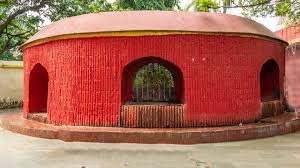Patna, the capital of Bihar, is home to several ancient and sacred sites, each holding a significant place in history and mythology. Among them, the Agam Kuan Temple stands out as one of the most mystical and revered places in the city. Devotees and history enthusiasts alike visit this site to seek blessings, unravel its mysteries, and experience its spiritual aura.
Whether you are a devotee of Goddess Shakti, a history lover, or a curious traveler, Agam Kuan Temple offers a unique experience blending faith, history, and mystery. Let’s explore its mythological significance, architectural marvel, rituals, and spiritual energy.
The Legend Behind Agam Kuan Temple
A Well of Mystical and Historical Significance
The Agam Kuan, meaning “Unfathomable Well,” is believed to date back to the Mauryan Empire.
- Connection to Emperor Ashoka
- According to historical beliefs, the Agam Kuan well was built during the reign of Emperor Ashoka (273–232 BCE).
- Some legends suggest he used this well to execute prisoners by throwing them into its seemingly bottomless depths.
- After his transformation into a peaceful ruler and follower of Buddhism, the well became a symbol of purification and spiritual renewal.
- Association with Goddess Shakti
- Another popular legend connects Agam Kuan Temple to Goddess Shakti (Durga).
- It is believed that Sita, the wife of Lord Rama, had worshipped here, making it an important spiritual center.
- Even today, devotees come to seek blessings for prosperity, protection, and fulfillment of desires.
These legends make Agam Kuan Temple a fascinating site, where history and spirituality intertwine seamlessly.
The Architectural Marvel of Agam Kuan Temple
1. The Mysterious Well
- The Agam Kuan well, around 105 feet deep and 20 feet in diameter, is the main attraction of this site.
- It is built with eight arched windows, enhancing its unique design and mystery.
- Even after centuries, the well’s depth remains unknown, adding to its enigmatic charm.
2. The Temple of Goddess Shitala
- Adjacent to the well stands the Shitala Devi Temple, dedicated to Goddess Shitala, the healer of diseases and protector from misfortunes.
- The sanctum houses the sacred idol, and devotees offer flowers, sweets, and sacred water as part of their prayers.
3. Ancient Carvings and Structures
- The temple complex exhibits old stone inscriptions and sculptures, reflecting India’s rich architectural heritage.
- The intricate carvings on temple walls narrate stories from Hindu mythology, offering a glimpse into the spiritual and artistic brilliance of ancient India.
With its mysterious well and sacred shrine, the temple is a blend of history, faith, and timeless beauty.
The Divine Rituals and Traditions at Agam Kuan Temple
1. Daily Worship and Aarti
- The temple follows a strict daily worship routine, attracting devotees from far and wide.
- The day begins with the Mangala Aarti, where devotees light lamps and chant prayers in devotion to Goddess Shitala.
2. Special Rituals and Offerings
- Devotees tie red threads and offer coins near the well, believing that their wishes will be granted.
- Pouring holy water into the well is considered auspicious and is believed to remove negative energy.
- On specific days, devotees offer mustard oil and neem leaves to seek protection from diseases.
3. Festivals and Grand Celebrations
The Agam Kuan Temple comes alive during Hindu festivals, drawing huge gatherings of devotees.
- Navratri – Nine days of worship, fasting, and celebrations dedicated to Goddess Durga.
- Chhath Puja – A grand festival where devotees worship the Sun God near sacred water bodies.
- Makar Sankranti – Special prayers and food offerings mark the beginning of the harvest season.
- Shitala Ashtami – A significant festival where devotees pray to Goddess Shitala for health and well-being.
During these festivals, the divine energy and spiritual atmosphere of the temple reach their peak, making it an ideal time to visit.
Spiritual and Healing Significance of Agam Kuan Temple
1. A Place of Divine Blessings
- Devotees believe that prayers at Agam Kuan Temple bring protection, good fortune, and prosperity.
- Worshippers seek blessings for health, success, and relief from misfortunes.
2. Mystical Healing Powers
- The holy water from the well is considered to have healing properties.
- Many devotees take the water home to cure ailments and purify their surroundings.
3. A Center for Spiritual Awakening
- The serene surroundings make it an ideal place for meditation and inner peace.
- The vibrations of sacred chants and rituals create a deeply spiritual experience.
For anyone seeking divine guidance, spiritual healing, or historical exploration, Agam Kuan Temple is a must-visit destination.
How to Reach Agam Kuan Temple
The Agam Kuan Temple is easily accessible from various parts of Patna.
- The nearest airport is Jay Prakash Narayan International Airport (PAT), around 10 km away.
- From the airport, you can hire a cab or auto-rickshaw to reach the temple.
- The nearest railway station is Patna Junction, just 6 km away.
- Local transport like autos and buses can take you to the temple conveniently.
For a smooth and hassle-free visit, it is best to plan your trip during the early morning hours, when the temple is less crowded and the atmosphere is at its most peaceful.
Conclusion: A Temple of Mystery, Faith, and History
The Agam Kuan Temple is more than just a place of worship—it is a historical marvel, a spiritual powerhouse, and a site of divine energy. From its mystical well and powerful legends to its healing rituals and grand festivals, this temple continues to attract devotees, historians, and seekers of truth.
If you ever find yourself in Patna, make sure to visit this mystical temple, offer your prayers at the sacred well, and experience the rich cultural and spiritual heritage of India.





